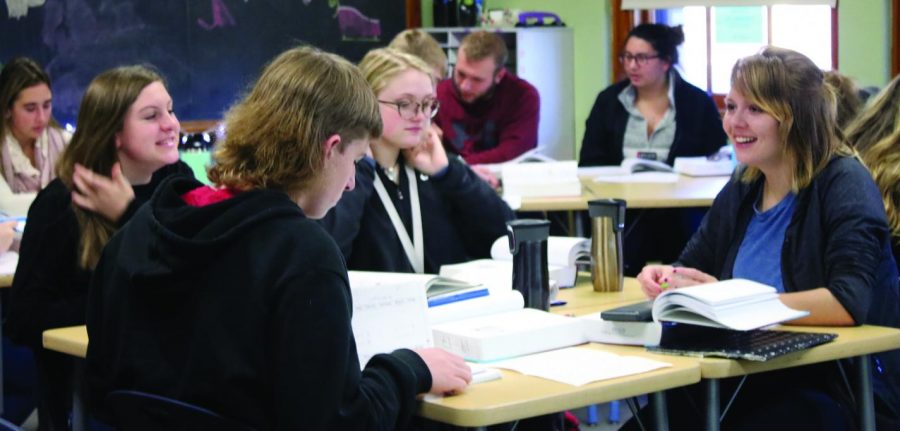Changes in math = better scores?
The old saying goes that the definition of insanity is to do the same thing over and over again and expect different results. In this case, the EHS Math department has chosen to do something new. Instead of teaching the same old math out of the same old textbook, then sent off to do the same old homework the same old way, the math department has decided to bring in a new, dramatically different curriculum to improve math scores in the entire school district.
Select math classes in the high school are currently piloting the number-one recommended math curriculum in the nation. The new College Preparatory Mathematics (CPM) books are an entirely new breed, using group discussions in classrooms to promote long-term retention of topics and better overall understanding of concepts. According to CPM’s mission statement, the curriculum is designed to “engage all students in learning mathematics through problem solving, reasoning, and communication.” Compared with the old curriculum that all students are familiar with, CPM is a drastic change, and alters the classroom environment into a discussion-based learning experience.
Assistant superintendent and head of the math department, Bridgett Muse, said she did research about CPM before the decision was made to pilot the program, and found that it was very highly rated by independent studies and promoted great long-term retention of topics in postsecondary school. “We need to make a change and this is what is different,” Muse said. “Doing the same thing isn’t going to yield results, so if we continue to do the same thing and use the same textbooks we have been, just newer versions, I don’t see how that’s going to lead to better test scores.”
When the school district began looking at new math curriculums to pursue based on poor test scores, the curriculums of other school districts who were performing better than the Eaton in mathematics were investigated. Platte Valley and Windsor, both of which outperform Eaton in math in the ACT and PARCC tests, use the CPM curriculum. After reviewing independent research, the school district decided to pilot the program until a decision is made by the secondary math committee this coming March. It is currently being piloted in two classes at EMS, and in Algebra 1, Geometry, and Algebra 2 at EHS.
Math teacher Kayla Johnson, one of the two EHS teachers who is currently piloting the program, acknowledges that it has its great days and its bad days, although she likes the curriculum overall. “I’d say about every three out of every four weeks, I love it,” Johnson said. She and her class have had to overcome obstacles in the way they interpret the textbook and represent answers on homework assignments. Johnson said that the first four or five homework assignments she assigned her Algebra 1 and Algebra 2 classes were very incomplete and the students had a lot of questions. However, as the year has moved on, Johnson can tell her students have overcome that obstacle when she looks at the progress they have made in their math composition notebooks.
For Johnson, the way the students are able to use their graphing calculators is the best part of CPM, saying that they are the most “fluid with their calculators” out of any class she has had. Johnson appreciates the discussions that CPM allows her students to have, as well. “Their conversations are so rich sometimes that I wish I could have a little recorder on their desks listening to what they say,” Johnson said.
Algebra 2 student Makayla Chumacero (18) said, “I like that it challenges you and it has you learn a topic the you have never seen before so you get to work through it and see what’s coming.”
The decision in March will be made by the secondary math committee, composed of all of the math teachers at the middle school and high school, Muse, and both of the principals. Unfortunately, the PSAT and SAT scores will not be out before March, so a decision will be made based on classroom grades and survey information collected from parents and students. Although having those test scores would be helpful, a decision must be made prior to their release because, if the adoption of the new curriculum occurs, teachers need to be properly trained to teach it over the summer and textbooks will need to be purchased as soon as possible.
As for higher levels of math like Algebra 2 Honors, Precalculus, and Calculus, the door remains open for adopting CPM textbooks, but is unlikely due to concurrent enrollment for Calculus students at UNC. Muse said, “We always want to align [our curriculum] with UNC.” Since Algebra 2 Honors and Pre Calculus are the pathways to Calculus, Muse said a discussion must take place as to whether or not the traditional books should be swapped for CPM books.
Right now, the district’s main focus is simply to improve test scores in mathematics and to prepare kids for college. Not only are test scores not where they need to be, Muse said that remediation rates from kids who have gone off to college are higher than they should be. Kids who go off to college are sometimes “remediated” to lower level math classes or might have to repeat a class if they can not keep up with the one they enrolled in. Remediation reports come in from the state of Colorado every year, and Muse said they are a key factor in deciding on new curriculums.
If the curriculum is adopted, students will be taught from the CPM textbooks for six more years until their cycle is up and the school buys new ones.







